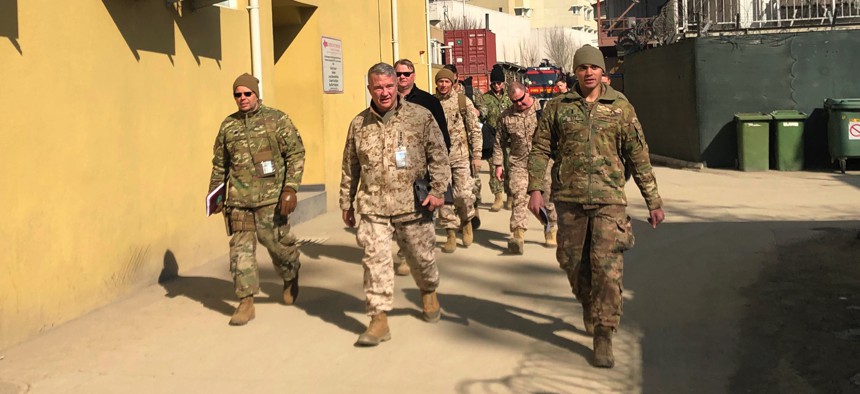
Marine Gen. Frank McKenzie, center, top U.S. commander for the Middle East, makes an unannounced visit, Friday, Jan. 31, 2020 in Kabul, Afghanistan. AP / Lolita Baldor
Iran Threat Remains ‘Very High,’ US General Says
Amid Trump's maximum pressure policy, Iran still “actively” trying to destabilize the region, says CENTCOM’s Gen. McKenzie.
The year began with weeks of razor-sharp tensions between Iran and the United States, punctuated by the U.S. killing of an Iranian general and a retaliatory ballistic missile attack that injured more than 100 U.S. troops and threatened to draw the countries into outright war. But President Donald Trump decided not to escalate further, and the ensuing pair of relatively calm months lulled Washington into quiescence.
But a pair of tit-for-tat attacks between an Iran-backed militia and the United States in Iraq this week may end that complacency — even as Capitol Hill is grappling with the spread of coronavirus.
“I think the threat remains very high. I think the tensions have actually not gone down,” Gen. Frank McKenzie, the commander of U.S. Central Command, told reporters at the Pentagon on Friday, just hours after the United States carried out retaliatory airstrikes on five weapons depots inside Iraq used by Kata’ib Hezbollah, the Iranian-backed militant group. “Even though we may go days or a period of time without anything happening, I think we’re still in a period of significant risk.”
On Dec. 27, a Kata’ib Hezbollah attack killed an American contractor, prompting Trump to order the killing of Iranian Gen. Qassem Soleimani. Iran responded with a missile attack on another Iraqi air base, al-Asad. The United States declined to strike back, and Pentagon officials and Republican lawmakers have boasted that the January killing had “reset deterrence” in the region, after months of rocket attacks from Iranian proxies and ship seizures in the Gulf. President Trump at the time said that Iran “seems to be backing down.”
Related: Iran Has Far More Coronavirus Cases Than It Is Letting On
Related: Trump’s Iran Strategy Isn’t Working as Well as He Thinks
Related: Iran’s Smart Strategy
Since the attack on al-Asad, “the situation seems to have de-escalated,” Senate Armed Services Committee Chair Sen. Jim Inhofe, R-Okla., said during a Thursday morning hearing.
But McKenzie said that Iran is still “actively seeking ways to achieve destabilization that would allow them to escape the strictures of” the Trump administration’s “maximum pressure” campaign, which has placed punishing sanctions on Tehran in an effort to force them to negotiate a new nuclear deal and abide by a series of other demands laid out by Secretary of State Mike Pompeo.
In a separate appearance before the Senate Armed Services Committee on Thursday, McKenzie also said that he believed that Iranian attack on al-Asad that occurred on Jan. 8 would likely make it easier for Iran to attack the U.S. directly in the future.
“This state-sponsored missile attack crossed a threshold compared to previous attacks and has probably set a lower bar for future actions by the regime,” he said.
On Friday, McKenzie added that although Iran is struggling to exert the same level of command and control over its various proxies in the region in the wake of Soleimani’s death, “none of their core objectives have changed.” Soleimani’s replacement so far hasn’t lived up to his infamous predecessor’s legacy — but it doesn’t appear to be for lack of effort.
“I don’t think that someone is going to be as good as [Soleimani] in the short term. We’ll see in the long term,” McKenzie said.
Iran is also likely facing internal pressure over its handling of the coronavirus outbreak that has resulted in hundreds of publicly reported deaths, McKenzie said. (CENTCOM believes that Iran has underreported them.) That pressure could be prompting Tehran to lash out. Iranian propaganda outlets are already pushing the false narrative that coronavirus originated as a U.S. bioweapon.
“In authoritarian states, they can react to an internal crisis by one of two ways: they can turn inward or they can turn outward,” McKenzie said. “History typically tells us authoritarian states turn outward in order to marshal the people behind them against a common foe, external, either manufactured or real — and I think it’s very possible that’s what we’re seeing now.”
Inside Iraq, McKenzie said, CENTCOM is aware of “a variety of other” weapons storage sites used by Kata’ib Hezbollah, which it did not strike out of “restraint.” Many of those sites are commingled with a civilian population that the United States seeks to avoid harming when it evaluates targets.
Thursday's airstrikes were “attempting to send a strong enough message If it doesn’t work, we have plenty more places we can go in and go to work,” McKenzie said.
“There are a lot of storage sites across the country we think we know where most of them are.”
Critics have argued that Trump’s “maximum pressure” campaign is making Americans less safe, escalating tensions with Iran unnecessarily and raising the chance of state-on-state war between the two nations. The airstrikes come less than 24 hours after the House passed a bipartisan resolution that seeks to limit Trump’s ability to wage war on Iran without Congress’s approval. That binding resolution now awaits Trump’s signature or veto.
Joint Chiefs Chairman Gen. Mark Milley, speaking to reporters at the Pentagon prior to the retaliatory strikes on Thursday night, declined to speculate on the timing of the March 11 attack on Taji air base, which occurred on Soleimani’s birthday.
“There could be a lot of reasons,” he said. “It could be coronavirus, it could be rogue Shia militia groups, it could be Soleimani’s birthday. It could be a lot of things. Don’t know.”
McKenzie on Friday morning urged against complacency.
“The illusion of normality is just that — the illusion of normality,” he said.





